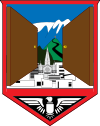Manizales
| Manizales | |||
|---|---|---|---|
| City | |||

Manizales, Caldas
|
|||
|
|||
| Motto: The city of open doors – World capital of coffee | |||
 Location of the city and municipality of Manizales in the Department of Caldas |
|||
| Location in Colombia | |||
| Coordinates: 5°06′N 75°33′W / 5.100°N 75.550°WCoordinates: 5°06′N 75°33′W / 5.100°N 75.550°W | |||
| Colombia |
|
||
| Region | Andean Region | ||
| Department | Caldas | ||
| Foundation | October 12, 1849 | ||
| Government | |||
| • Mayor | Octavio Cardona Leon | ||
| Area | |||
| • City | 571.84 km2 (220.79 sq mi) | ||
| Elevation | 2,160 m (7,090 ft) | ||
| Population (2015) | |||
| • Urban | 369,997 | ||
| • Metro | 552,155 | ||
| Demonym(s) | Manizaleño | ||
| Time zone | Eastern Time Zone (UTC-05) | ||
| Postal code | 170001-17 | ||
| Area code(s) | 57 + 6 | ||
| Website | Official website (Spanish) | ||
Manizales (Spanish pronunciation: [maniˈsales]) capital of the Department of Caldas, is a city and municipality in central Colombia, near the Nevado del Ruiz volcano.
Presently, the city is the main center for the production of Colombian coffee and an important hub for higher educational institutions.
Manizales was founded on October 12, 1849, The city was founded by a group of twenty antioquians (The Expedition of the 20), who came from Neira and Salamina. There is a strong Spanish influence in the culture and the population was very homogeneous, mostly white, until other ethnic groups migrated to the city in search of the universities.
Manizales is the capital city of one of the smallest Colombian departments. The city is described as having an "abrupt topography", and lies on the Colombian Central Mountain Range (part of the longest continental mountain range, The Andes), with a great deal of ridgelines and steep slopes, which, combined with the seismic instability of the area, has required architectural adaptations and public works to make the city safer. Even though Manizales has this very difficult topography, there are many coffee plantations in its fertile lands. The city is located in the northern part of the Colombian Coffee-Growers Axis ("Eje Cafetero"), near the volcano Nevado del Ruiz, which has an altitude of 5,321 meters (17,457.3 ft).
It is in the basin of the Chinchiná River and sub-basin of the Guacaica River. Its natural threats are earthquakes, mud slides, and volcanic eruptions.
Under the Köppen climate classification, Manizales has a subtropical highland climate (Cfb). Despite being located in the tropics, and due to its high altitude, the city seldom gets very hot during the course of the year, featuring spring-like temperatures throughout the year. Because of its tropical location, there are only two seasons in the city: the wet and dry seasons that alternate throughout the year with each lasting about three months. Monthly averages are quite uniform. Manizales receives about 1,500 millimetres (59 in) of precipitation a year, with October being wettest.
...
Wikipedia



